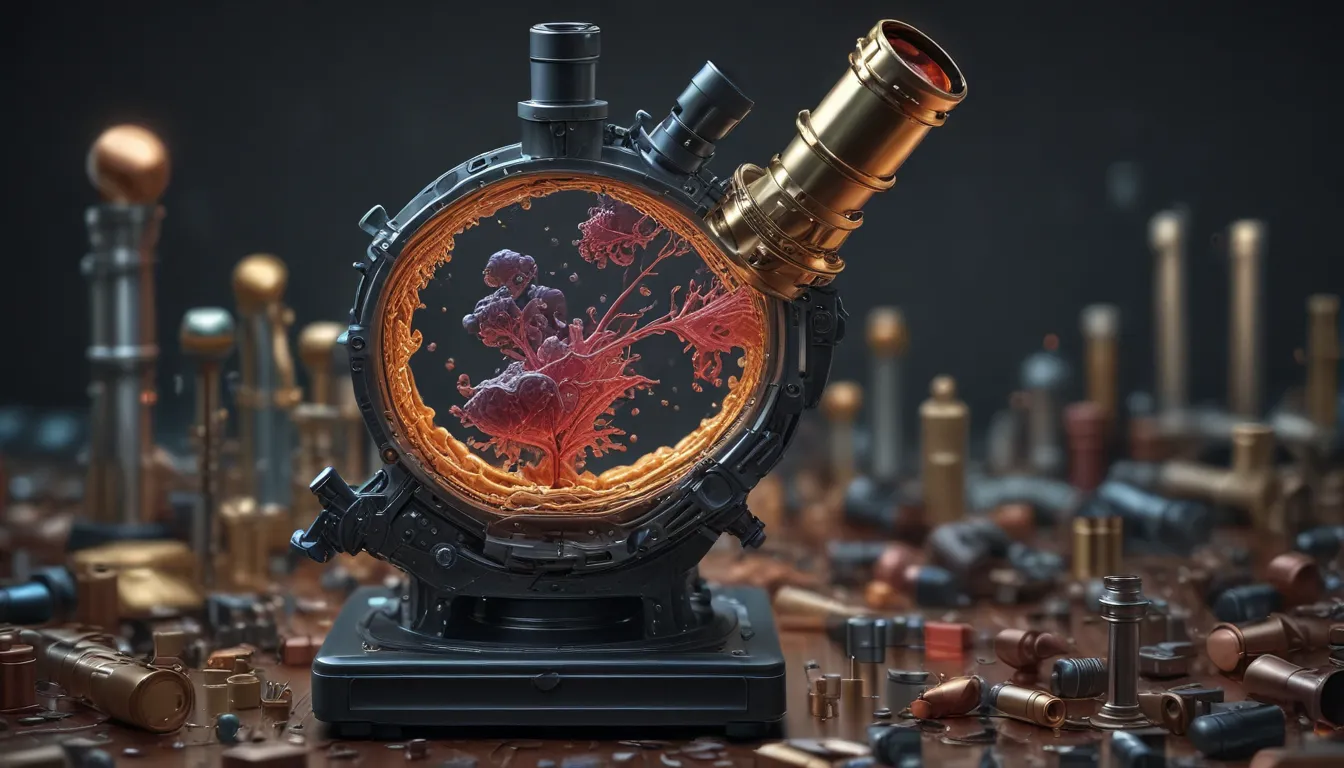A Note About Images: The images used in our articles are for illustration purposes only and may not exactly match the content. They are meant to engage readers, but the text should be relied upon for accurate information.
Welcome to the intriguing realm of microscopy, where hidden wonders and intricate details await discovery. In this article, we will delve into 18 captivating facts about microscopes that will open your eyes to the boundless wonders of the microscopic world. From the invention of the microscope to its impact on various fields, join us on a journey of exploration and awe-inspiring revelations.
A Glimpse into a New Dimension: The Invention of the Microscope
The late 16th century saw the birth of the microscope, a groundbreaking invention that revolutionized scientific exploration. By allowing us to peer into a whole new dimension, the microscope unveiled a universe of objects and organisms that were once invisible to the naked eye. This pivotal moment sparked a wave of discovery and transformed our understanding of the natural world.
Illuminating the Microscopic Universe: Types of Microscopes
Microscopes come in various types, each designed for specific purposes. The most common type is the light microscope, which uses visible light to illuminate and magnify specimens. On the other hand, electron microscopes utilize a beam of electrons to achieve unparalleled magnification and resolution, unveiling ultra-fine details that were previously unseen.
Peering into the Submicroscopic: Magnification Power of Microscopes
One of the most remarkable abilities of microscopes is their magnification power, which allows us to see objects in extraordinary detail, up to a million times larger! The magnification power of a microscope determines how much larger the image appears compared to the actual object, unveiling hidden intricacies and structures that are invisible to the naked eye.
The Fine Art of Clarity: Resolution in Microscopy
Resolution plays a crucial role in microscopy, determining the microscope’s ability to distinguish between closely spaced objects. The higher the resolution, the finer the details we can observe. Modern microscopes boast resolutions that reveal structures as small as a few nanometers, unlocking a world of clarity and precision in scientific exploration.
Unveiling the Building Blocks of Life: Cell Structure
Microscopes have played a pivotal role in revolutionizing our understanding of cells, the fundamental building blocks of life. By studying cell structures, including the nucleus, mitochondria, and other organelles, researchers have gained invaluable insights into fields like biology and medicine. The observation of cells under the microscope has paved the way for groundbreaking discoveries and advancements in scientific research.
The Abundance of Life in the Microscopic World
Beneath the lens of a microscope lies a hidden universe teeming with life. From bacteria and algae to fungi and protozoa, the microscopic world is rich with diverse microorganisms that play vital roles in ecosystems. These tiny organisms wield a profound impact on our planet, showcasing the interconnectedness and complexity of life on a microscopic scale.
Bridging Science and Creativity: Microscopic Art
Microscopy has given rise to a unique form of art known as microscopic art, where artists use microscopes to capture striking images of the unseen world. By transforming scientific observations into visually captivating works of art, these artists bridge the gap between science and aesthetics, showcasing the beauty and intricacy of the microscopic realm in a creative and inspiring way.
Pushing Boundaries with Microscope Innovations
Microscope technology continues to evolve, pushing the boundaries of observation and exploration. Innovations like confocal microscopy and scanning probe microscopy bring new capabilities to the table, enabling scientists to delve into uncharted territories and unravel mysteries at the microscopic level. Each breakthrough in microscopy opens new doors to scientific discovery and understanding.
Uncovering Clues with Forensic Microscopy
Microscopes play a vital role in forensic investigations, where forensic microscopists analyze trace evidence to uncover vital clues in criminal cases. By meticulously examining fibers, hairs, and fingerprints under the microscope, forensic experts extract valuable insights that help solve mysteries and bring justice to light. The microscopic details hold the key to unraveling complex cases and shedding light on the truth.
Appreciating the Beauty Within: Microscopic Gems
Microscopy unveils the hidden beauty of natural and synthetic materials, allowing us to explore intricate structures and mesmerizing colors in gemstones, crystals, and minerals. By peering through the lens of a microscope, we discover a hidden treasure trove of beauty and elegance that transcends the naked eye. It’s a journey of discovery and wonder into the exquisite world of microscopic gems.
Insights at the Cellular Level: Medical Diagnostics with Microscopes
Microscopes serve as indispensable tools in medical diagnostics, enabling pathologists and medical professionals to examine tissue samples and blood smears at the cellular level. This aids in the diagnosis of diseases such as cancer and infections, providing crucial insights into the inner workings of the human body. Microscopy plays a vital role in healthcare by enhancing diagnostic accuracy and improving patient outcomes.
Exploring Diversity with Microscopy
Microscopy allows us to explore the breathtaking diversity of the natural world, unveiling intricate details that make each species unique. From the delicate wings of insects to the intricate patterns on plant leaves, microscopes provide a window into the wondrous tapestry of life on Earth. It deepens our appreciation for the beauty and complexity of nature, inspiring awe and reverence for the world around us.
Balancing Beneficial and Harmful: Microorganisms and Disease
Microscopic organisms can be both beneficial and harmful to human health, with some causing diseases while others maintain a healthy balance in our bodies. Microscopy enables scientists to study pathogens, understand disease mechanisms, and develop effective treatments to combat infections and illnesses. By unraveling the secrets of microorganisms, researchers pave the way for transformative advancements in medicine and public health.
Precision in the Tiny Realm: Microscopic Engineering
Microscopes serve as essential tools in various fields of engineering, enabling engineers to inspect materials, analyze microcircuits, and fabricate nanoscale devices with precision. Microscopic engineering drives advancements in electronics, materials science, and nanotechnology, pushing the boundaries of innovation and technological progress. By harnessing the power of microscopes, engineers unlock new possibilities in the realm of the tiny.
Capturing the Unseen: Microscopic Photography
Microscopic photography has emerged as a captivating art form, with photographers utilizing advancements in camera technology to capture stunning images of the microscopic world. These photographs serve as a visual bridge between science and art, inviting viewers to appreciate the hidden beauty that surrounds us in the microscopic realm. Through the lens of a camera, we embark on a visual journey of exploration and discovery into the unseen wonders of the microscopic universe.
A World Within a Drop: Microscopic Ecosystems
Even a single drop of water contains a thriving ecosystem of microorganisms, offering a glimpse into the intricate microcosms that exist within. By observing water samples under the microscope, researchers gain insights into the delicate balance of life within a tiny droplet, unraveling the interconnected web of microorganisms that coexist in harmony. It’s a testament to the richness and complexity of life on a microscopic scale, showcasing the beauty and diversity of microcosmic ecosystems.
Beyond Earth: Microscopy in Astronomy
Microscopy transcends the boundaries of Earth, extending its reach to the cosmos. Astronomers use microscopes to examine cosmic dust particles, analyzing their composition and structure to uncover the mysteries of the universe. By studying the microscopic realm of cosmic dust, researchers gain valuable insights into the vastness of space and the celestial bodies that populate our cosmic landscape. Microscopy in astronomy offers a unique perspective on the universe, shedding light on the secrets of the cosmos.
Illuminating Young Minds: Microscopy in Education
Microscopes play a vital role in science education, empowering students to engage in hands-on exploration and discovery. By peering into the microscopic world, students cultivate critical thinking skills and ignite their curiosity about the natural world. Microscopy fosters a deeper understanding of scientific concepts and inspires a sense of wonder and awe in young minds, paving the way for future generations of aspiring scientists and explorers.
Conclusion: Embracing the Marvels of Microscopy
As we journey through the mesmerizing world of microscopy, we are captivated by the complexity and wonder that lie beyond the naked eye. From uncovering hidden gems to exploring microscopic ecosystems, microscopes open a gateway to a universe of discovery and revelation. With each advance in microscopy, we are reminded that there is always more to explore and unveil, even in the tiniest of realms. Embrace the marvels of microscopy and embark on a journey of awe-inspiring exploration into the microscopic universe.
Was this article helpful?
Our dedication to delivering accurate and engaging content drives our mission to provide valuable insights and information to our readers. Each fact on our site is contributed by real users like you, ensuring a diverse and credible source of knowledge. Our meticulous review process guarantees the highest standards of accuracy and reliability, offering you a trusted source of information as you delve into the wonders of the microscopic world. Trust in our commitment to quality and authenticity as you embark on a journey of discovery with us.






